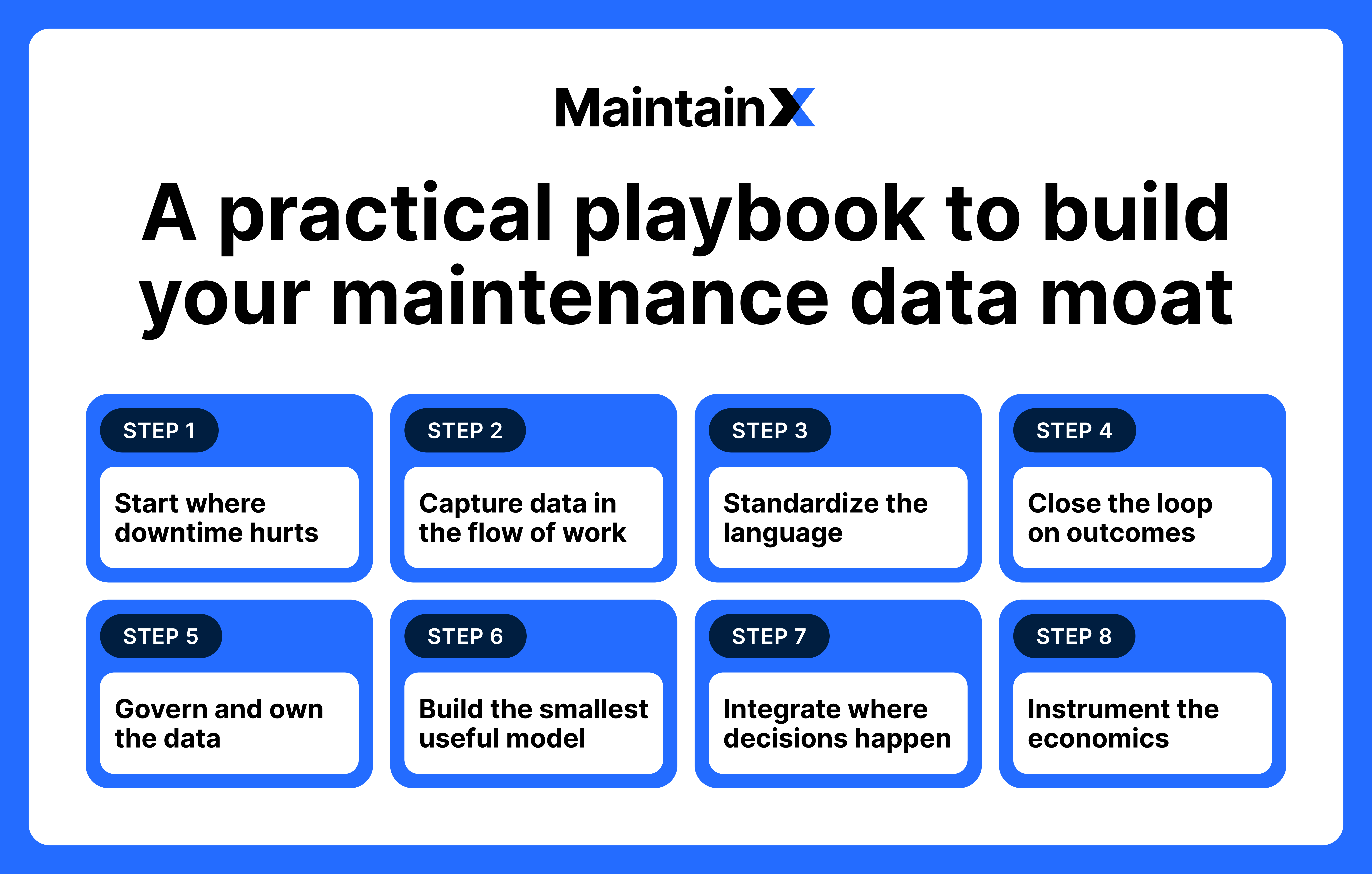
Industrial leaders are racing to deploy AI, spending $100 billion every year along the way. The problem is, this massive investment is often being placed on a hollow foundation. While billions of dollars are being bet on production monitoring solutions as the pillars of this AI strategy, these platforms are only capturing half the data needed to get value. They only see what happens to equipment, not why it happened.
This missing context often lives in maintenance teams and with technicians that have a better view of what is happening in a plant than almost anyone else. They spend their days inspecting, troubleshooting, and repairing equipment. In doing so, they gain knowledge no standard AI model or third-party data set can match, including:
- Context, like operating conditions, ambient variables, and duty cycles.
- Causality, including fault codes paired with root causes, and corrective actions.
- Resolution, such as time to repair, tests performed, and pass/fail outcomes.
- Tacit know-how, like photos, voice notes, annotations—the ’why’ behind the ’what.’
Right now, this insight lives in the heads of technicians or gets buried in free-text notes. But if digital tools can be integrated into everyday maintenance workflows, they can capture this knowledge and turn it into structured, ownable intelligence. If done consistently, the result is a living library of how your assets behave, one that can be used by AI to build compounding value with every work order that is closed.
Why maintenance data is your biggest advantage
Using standard AI models is table stakes—anyone can do it (and is doing it). The real differentiator is using data that only you have, which is why maintenance intelligence is a huge advantage. It gives you:
- Proprietary context: Your assets fail in ways unique to your processes, environments, and operating conditions. That failure signature is your competitive moat.
- Compounding returns: Each work order you close is added to the training data. While competitors start from zero with off-the-shelf solutions, your models get smarter with every shift.
- Defensive positioning: OEMs and vendors want your operational data—it powers their products. Capturing and governing this data ensures you're building advantage, not renting it.
A practical playbook to build your maintenance data moat
You know maintenance data is a massive competitive advantage. You know it’s being created every minute of every shift. But what you might be missing is how to make sure that data doesn’t get locked in Word documents, walk out the door with a retiring technician, or, worst of all, evaporate into thin air. Even when you secure the data, you need to build processes that make it repeatably accessible and actionable.
This eight-step playbook will help you build a strategy to capture and action maintenance data so you can gain an edge that no one else has.

1. Start where downtime hurts
Pick an asset class that has the biggest impact on operations if it experiences unplanned downtime. For example, let’s say a broken compressor leads to $50,000 of lost production a minute. Focusing your efforts on this asset group could save millions every year. Define three target KPIs that could help you understand and prevent downtime, like unplanned downtime, mean time to repair (MTTR), and first-time fix rate.
2. Capture data in the flow of work (not after)
Capturing data at the point of work not only means fewer errors, it also means technicians are more likely to use the tools that capture this data. There are no extra steps, or new processes to learn. One of the best ways to do this is with software designed for mobile devices. Technicians can scan QR or RFID codes to auto-populate asset IDs, use voice-to-text memos to dictate root-causes, snap a photo of broken components , or record a short clip of an abnormal sound.
3. Standardize the language
It’s not just about what data you collect, but how it’s structured so you can easily find the answers you’re looking for. Adopt a common taxonomy for assets, failure modes, symptoms, and actions. Pair free text with required picklists. For example, make it mandatory to add a standard failure code, cause code, and component ID before notes can be created. Standard terms are the difference between a searchable database and an unusable pile of notes.
4. Close the loop on outcomes
Without an outcome to learn from, AI models will always be missing a piece of the puzzle. Every work order should be labeled with pre-defined outcomes For example, was it resolved or not resolved? Which parts were used and steps taken? When was the next recurrence of a failure? That label is the gold your model learns from.
5. Govern and own the data
Bake data rights into OEM and integrator contracts so everything from telemetry to maintenance records produced on your site are your intellectual property. Define retention, access control, and redaction policies, especially for personally identifiable information in photos and notes. Have clear guidelines on what can and can’t be shared externally and how it’s shared.
6. Build the smallest useful model
Skip moonshots. Start with one high-leverage capability tied to your KPIs. For example, that might be ranking sensor alerts by likely impact using maintenance data from past fixes. Or it could mean using AI to propose the three most likely causes of failure based on symptoms and other context.
7. Integrate where decisions happen
Having all the data in the world is useless unless it drives action and optimization. That’s why AI needs to be embedded wherever action happens and decisions are made. Surface AI inside the software technicians already use (ideally a CMMS or EAM). Have it generate not only the suggestion, but the confidence level it has in its response, and the evidence for it (linked past jobs, photos, and checks). Let users provide feedback with a one-tap response (like "helpful/not helpful") to create continuous labels.
8. Instrument the economics
Track the impact of your initiative with metrics, like unplanned downtime hours, MTTR, schedule compliance, wrench time, parts consumption, overtime, and deferral risk. Attribute savings to the AI workflow you’ve created. For example, you might say that AI-assisted diagnoses led to an 18% decrease in MTTR, which equals an 8% reduction in maintenance costs and a 13% increase in production.
What data to collect for AI-ready maintenance records [Checklist]
This checklist will help you capture valuable data from frontline workers to create maintenance records that are structured for AI while providing actionable outputs.
Training and implementing AI for maintenance: A 90-day sprint plan
This 90-day blueprint turns maintenance data into a working AI assistant that technicians actually use.

Weeks 1–2: Frame and align
- Select your asset class and KPIs.
- Map systems (SCADA, historian, CMMS).
- Lock the taxonomy and outcome labels.
- Update OEM/contractor SOWs to confirm data ownership.
Weeks 3–6: Capture and connect
- Deploy in-flow capture (mobile/voice, QR tags).
- Connect CMMS to a secure data lakehouse.
- Start labeling outcomes.
- Run a small RAG assistant for procedures.
Weeks 7–10: Model and embed
- Train a lightweight anomaly triage or diagnosis model using the first wave of labeled data.
- Embed the assistant in the CMMS work order screen with one-tap feedback.
Weeks 11–12: Prove and decide
- Report KPI deltas and technician adoption.
- Decide to scale by asset class or site.
- Tune playbooks and permissions while expanding your taxonomy as needed.
Five pitfalls to avoid when implementing industrial AI
If an AI project fails, it’s often because teams fall into one or more of the following risks:
They create massive data lakes with no frontline adoption plan
Big, catch-all data lakes rarely move the needle without a clear workflow for how technicians will use insights on the floor. Start with one high-value use case, map the decisions and handoffs, then collect only the data required to drive those moments.
They over-index on sensor data while ignoring human commentary that explains why
Sensor data, like vibration and temperature readings, show what changed, but technician notes, photos, and short clips often reveal the reason behind that change. Without that crucial context, you won’t have enough information to avoid similar issues in the future. Combine sensor streams with structured frontline annotations to train models that diagnose causes—not just detect anomalies.
They are trapped by vendor contracts that let OEMs keep (or throttle) data
If your maintenance data lives behind an OEM paywall or rate limit, your AI roadmap isn’t yours. Negotiate data access up front, including APIs, export rights, and latency SLAs, or choose vendors that commit to open, portable data.
They don’t have a standard taxonomy
Without consistent asset hierarchies, fault codes, and failure modes across sites, your models learn noise and your metrics don’t line up. Define a lightweight, shared vocabulary early and enforce it in forms, imports, and integrations.
They build dashboards that don’t lead to decisions
Pretty charts don’t reduce downtime. Clear thresholds, alerts, and playbooks do. Tie every visualization to a specific decision, owner, and next action, ideally from the dashboard to a work order in one click.
Five data governance questions every executive should ask when implementing AI
Before green-lighting any AI initiative, pressure-test your plan with these five governance questions:
- Who owns every byte of data generated by our assets, on our site?
- Where in the workflow do we capture technician context, and is it standardized?
- Which three KPIs will our AI change in the next quarter, and how will we measure attribution?
- How do technicians give feedback to the model inside the CMMS/EAM they use today?
- What is our policy for sharing data with OEMs and service partners—and what do we get in return?
Stop renting your competitive advantage. Start compounding it.
The industrial AI race isn't about who writes the biggest check for the latest model. As the data drought intensifies and 95% of companies struggle to extract AI value, the winners will be those who solve a simpler problem: capturing the intelligence their maintenance teams generate every day.
Anyone can rent a powerful model. You cannot rent the context that makes it valuable in your plant. That context lives with the people who keep your assets running—in the photos they snap, the notes they dictate, the patterns they recognize after a decade on the floor.
Capture that intelligence as part of the work. Govern it like an asset. Feed it back into narrowly scoped AI that helps technicians fix problems faster and prevent them altogether. The more your organization pivots to AI, the more critical it becomes to activate this maintenance data and build the moat that compounds in value with every model upgrade.
In the industrial AI race, the winning edge won't be the model you buy. It will be the maintenance intelligence you own.

Chris é empresário de tecnologia e investidor anjo com experiência em finanças de compra e inovação em finanças SaaS. Antes de ser cofundador da MaintainX, ele construiu, liderou e vendeu a Voo, uma startup de consumo. Anteriormente, ele foi empreendedor residente na Deutsche Telekom Capital Partners. Chris é formado em Finanças pela McGill University e foi presidente de ex-alunos da McGill na Califórnia.

.png)

